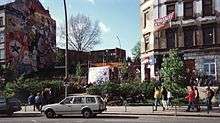Hafenstraße
Hafenstraße (German Hafen – harbour; Straße – street) is a common German abbreviation of St. Pauli-Hafenstraße,[1] a street in St. Pauli, a quarter of Hamburg, Germany.
| St. Pauli-Hafenstraße | |
 Location of the Hafenstraße in Hamburg  Hafenstraße (Germany) | |
| Location | St. Pauli, Hamburg, Germany |
|---|---|
| Coordinates | 53°32′47″N 9°57′34″E |
It is known for being a legalized squat. The initial squat was started in 1981 by people squatting empty flats in houses in the streets St. Pauli-Hafenstraße and Bernhard-Nocht-Straße.[1]
Today, Hafenstraße consists of 12 houses owned by a cooperative administered by the residents.
History

Although referred to as a squat, at certain points during its history various contracts existed between the occupants and the buildings' former owner, the City of Hamburg.
Between the initial occupation of the squat and 1992 there were often riots and violent conflicts between the squatters and police forces or groups of fascists mixed with hooligans. They have been referred to as helping originate the Black Bloc.[2]
To the squatter movement of the 1980s, Hafenstraße was a focal point for various social conflicts. Solidarity with these issues led to growing conflict with the state. Meetings were held at the end of the years 1984 to 1990, where up to 5000 people participated. Discussions covered topics such as squatting, anti-NATO politics, anti-nuclear politics, the question of political prisoners and international solidarity.
In 1987, after the first contract expired, barricades were built up to save the squat. A pirate radio station, "Radio Hafenstraße", was set up a month before to provide information on the situation. Autonomen also launched a coordinated arson attack on 13 department stores throughout the city, causing over $10,000,000 in damages.[3] After 8 days of barricades, a new contract was negotiated between the squatters, their supporters and the City of Hamburg. Social Democrat (SPD) mayor Klaus von Dohnanyi brought all the parties back to the negotiating table.[4]
In 1990 a campaign was started against Hafenstraße, stating that supporters of the Red Army Faction were living there. A raid using 1000 police was initiated by the Bundesanwaltschaft, the German General State Prosecutor, but no real evidence was found to support the allegations.
Legalization
After the final contract expired the houses were sold to a cooperative to defuse the potential for conflict between the residents and the state in 1995.[4]
In October 2007, a new house was built for 40 people at Bernhard-Nocht-Straße 26.
In March 2019, a drugs raid resulted in 19 arrests.[5]
Film
- Terrible Houses in Danger, Winter 1984/85, 45 mins
- Zwischen Dachziegel und Pflasterstein, 1985, 45 mins, Film about house occupations on Hafenstraße, Chemnitzstraße, Jägerpassage and Pinnasberg
- Die Augen schließen um besser zu sehen, 1986, 20 mins
- Irgendwie, irgendwo, irgendwann, 1987/88, 100 mins Reoccupation and barricade days
- Polizeiüberfall auf die Hafenstraße, 1989, 20 mins Eviction of wagenplatz
- Selbst das kleinste Licht durchbricht die Dunkelheit, 1990, 60 mins, Film about house raids
- Die Hafentreppe, Directors: Thomas Tode & Rasmus Gerlach. D 1991, 75 mins
- Empire St. Pauli – von Perlenketten und Platzverweisen. Documentary 2009, 85 mins[6][7]
See also
Notes
- The official German name is spelled "-straße" instead of "-strasse"
- Autonomia and the Origin of the Black Bloc accessed 7 November 2008
- Gelderloos, Peter. Anarchy Works.
- Bruns, Jana (20 January 2014). "'Protests make Hamburg different'". Retrieved 22 April 2019.
- "Drogenrazzia in der Hafenstraße – 19 Personen festgenommen (German)". Abend Blatt. 15 March 2019. Retrieved 22 April 2019.
- Empire St. Pauli – von Perlenketten und Platzverweisen
- St. Pauli Dokumentation vom Rotlichtviertel zur Sahnelage
Further reading
- Hermann, Michael u.a., Hafenstraße, 'Chronik und Analysen eines Konfliktes', Verlag am Galgenberg, ISBN 3-925387-34-X, 1987 (in German)
- Sigmund, Monika; Zu bunt: Wandbilder in der Hafenstraße, ISBN 3-00-000713-X, 1996 (in German)
- Mallet, Carl H; Die Leute von der Hafenstraße, Über eine andere Art zu leben, ISBN 3-89401-346-X, 2000 (in German)
- Lehne, Werner; Der Konflikt um die Hafenstraße, Kriminalitätsdiskurse im Kontext symbolischer Politik, Hamburger Studien zur Kriminologie, 18, ISBN 3-89085-893-7, 1994 (in German)
- Davidson, Nick; Pirates, Punks and Politics: FC St. Pauli - Falling in Love With A Radical Football Club, ISBN 1-907524-41-X 2014 (in English)